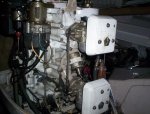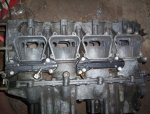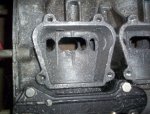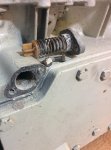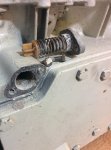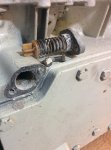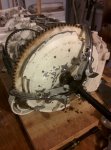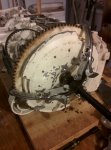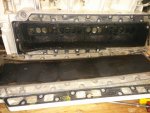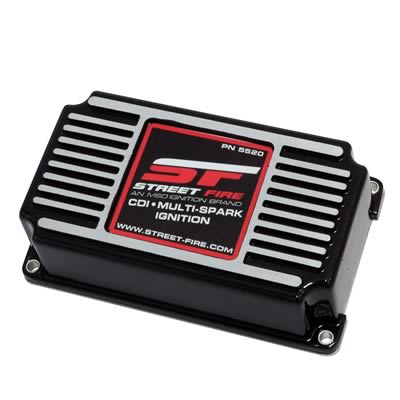Frank Acampora
Supreme Mariner
- Joined
- Jan 19, 2007
- Messages
- 12,004
Unless they are visibly worn, rings need not be replaced. Remember: They get a fresh shot of oil each revolution and outboards generally get little use compared to an automobile. Rings very rarely wear to the point of needing replacement. Measure the bores before you do anything. Chrysler tolerance for wear, barrel shape and taper was only .002. If out of tolerance, a bore job and oversized pistons are required. Note that during the same period OMC set tolerance at .005 so if you want to gamble---- Stock bore was 3.3125 inches. Stroke was 2.80 inches for a total displacement of right around 99 cubic inches.
The 105 came equipped with smaller 1 5/16 diameter venturi WB carbs. You can remove the manifolds and replace with manifolds,reeds, and TC carbs.(1 3/8 diameter venturi). These can be found on any Force 120 or 125. They also came on SOME Chrysler 120 and all 125 and 140. You won't get 120 horsepower but you will get an honest 90 at the prop.
The 105 was made for many years and was rated at the powerhead, Back in , I think, 1982 NMMA mandated that ALL outboards were to be rated at the prop. Chrysler took the 105 and with no changes other than decals called it a 90. Thus the reasoning for the honest 90 HP statement.
I don't see your distributor but in 1976 it should have had an electronic one. If it does not you can get a slight performance gain by swapping in an electric eye dist. They are more precise and you don't need to worry about setting points or point bounce.
If you keep the distributor do not set the belt tension too tight. If you do, believe it or not, you will have shifting problems. To set belt tension an .010 feeler gauge when pressed to the center of the belt should deflect the belt about 3/16 inch before bending. You can set the timing to 30 Degrees BTDC and be safe but the engine really likes to run at 32 BTDC. If you do that be certain to use only street auto pump gas so you are sure of the octane.
You also have the option of converting to Prestolite non-distributor ignition. It requires all ignition components, flywheel and stator mount. You will need to drill and tap 5 holes to install the stator mount and you will need a special thick washer under the mount to keep the top bearing from riding up. I don't know if this washer is still available but I do know that some Force 40 engines did have it. At any rate, a good machine shop should be able to make one relatively cheaply.
The 105 came equipped with smaller 1 5/16 diameter venturi WB carbs. You can remove the manifolds and replace with manifolds,reeds, and TC carbs.(1 3/8 diameter venturi). These can be found on any Force 120 or 125. They also came on SOME Chrysler 120 and all 125 and 140. You won't get 120 horsepower but you will get an honest 90 at the prop.
The 105 was made for many years and was rated at the powerhead, Back in , I think, 1982 NMMA mandated that ALL outboards were to be rated at the prop. Chrysler took the 105 and with no changes other than decals called it a 90. Thus the reasoning for the honest 90 HP statement.
I don't see your distributor but in 1976 it should have had an electronic one. If it does not you can get a slight performance gain by swapping in an electric eye dist. They are more precise and you don't need to worry about setting points or point bounce.
If you keep the distributor do not set the belt tension too tight. If you do, believe it or not, you will have shifting problems. To set belt tension an .010 feeler gauge when pressed to the center of the belt should deflect the belt about 3/16 inch before bending. You can set the timing to 30 Degrees BTDC and be safe but the engine really likes to run at 32 BTDC. If you do that be certain to use only street auto pump gas so you are sure of the octane.
You also have the option of converting to Prestolite non-distributor ignition. It requires all ignition components, flywheel and stator mount. You will need to drill and tap 5 holes to install the stator mount and you will need a special thick washer under the mount to keep the top bearing from riding up. I don't know if this washer is still available but I do know that some Force 40 engines did have it. At any rate, a good machine shop should be able to make one relatively cheaply.
Last edited:




















